Ceiling lighting with LED strip: placement and design options

Ceiling lighting with LED strip is an original design solution that allows you to make the ceiling area unique. In order for this technique of ceiling decoration to be stylish and appropriate, it is necessary to study the subtleties of its placement and the most beneficial design techniques.

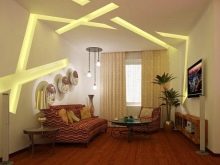
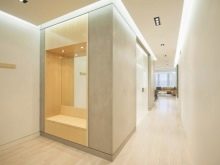
Peculiarities
LED strip is a functional lighting fixture with a mass of diode fixtures. The structure consists of a base with an adhesive surface and a protective film. Some varieties are fixed to the ceiling with plastic brackets. At the very base, there are auxiliary components, a contact pad and LEDs. To ensure even illumination, the light sources are placed at the same distance from each other.

This material is quite flexible, the tape is sold in reels, eliminating the formation of creases, and has cut lines. It is an auxiliary lighting, although the power of this lighting fixture often allows you to replace central lighting. The power consumption of 1 m of tape is from 4.8 to 25 watts.
In this case, the number of LEDs per 1 m can be from 30 to 240 pieces. Its uniqueness lies in its cost-effectiveness: a 10-meter cut is less energy-efficient than a conventional incandescent lamp.
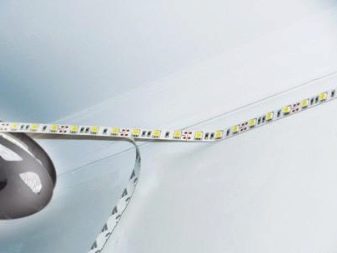
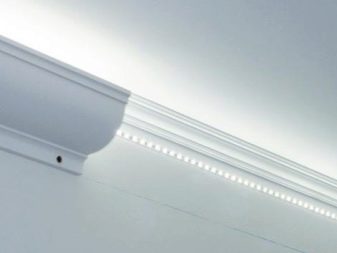
Resistors eliminate the possibility of voltage surges, they limit the flow of current. The width of the tape can reach 5 cm. The size of the LEDs is also different, so some varieties shine brighter than others. If it is necessary to increase the intensity of the ceiling illumination, sometimes an additional row of diodes is soldered to the tape.

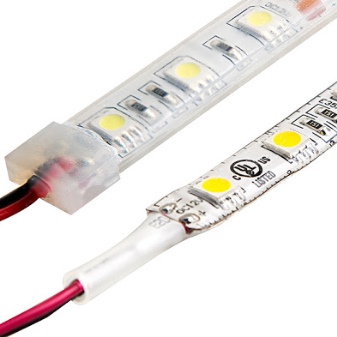
According to the tightness, LED strips are divided into three types:
- not having tightness (for ordinary premises);
- with an average degree of protection against moisture (for rooms with high humidity);
- in silicone, resistant to water (for the bathroom).
On the modern market, such products are presented in the form of classic white ribbons, RGB varieties and monochrome backlighting.
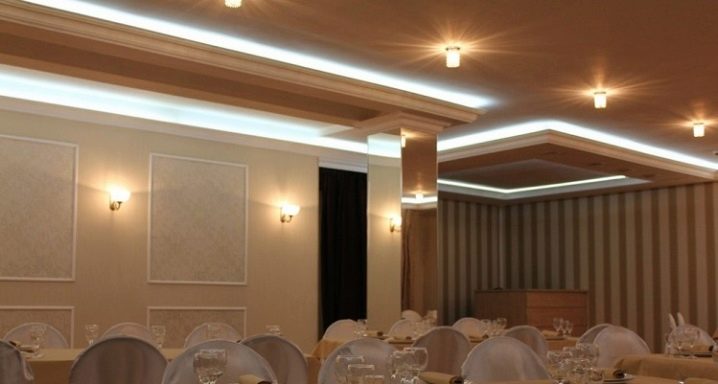
Advantages
The LED strip light is comfortable and quality.
It is a sought-after ceiling design tool for several reasons:
- is an impeccable technique for updating the interior composition of the interior of any room;
- sets a unique atmosphere for any room;
- it has an even and soft directional glow without flicker and noise;
- attaches directly to the ceiling;
- significantly saves energy consumption;
- has an attractive design;
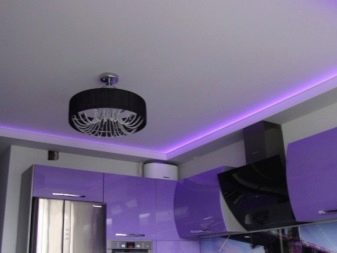
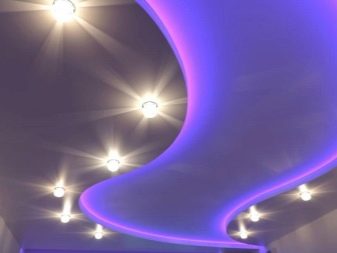
- durable - has a service life of about 10 years;
- differs in the possibility of choosing a color shade for the composition of the interior;
- due to flexibility, it allows you to take any shape;
- harmless, does not emit toxic substances into the air during operation;
- fireproof;
- does not affect TV and communication signals (does not cause interference).
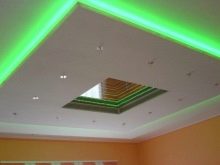
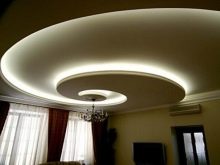

Such a ribbon can be a decoration for any room in the home.
You can decorate the ceiling with it:
- living room;
- children's;
- hallway;
- corridor;
- bathroom;
- bay window;
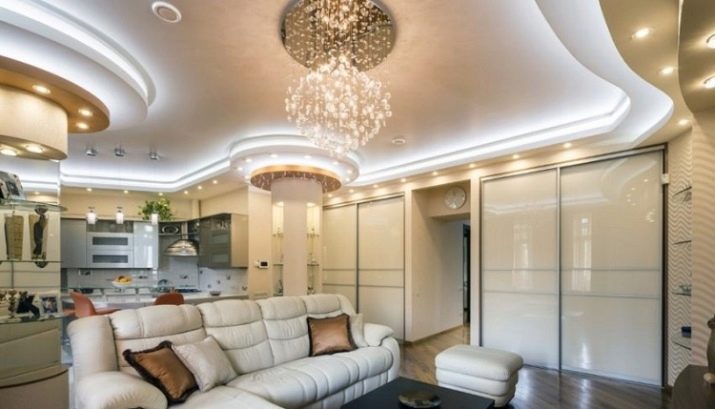
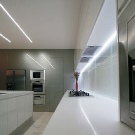
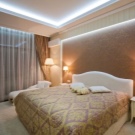

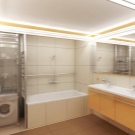
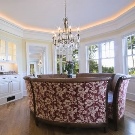
- kitchens;
- work cabinet;
- home library;
- glazed loggia;
- balcony;
- pantries.
Ribbon LED backlighting is affordable. It is easy to install, its installation can be done by hand, without involving outside specialists.
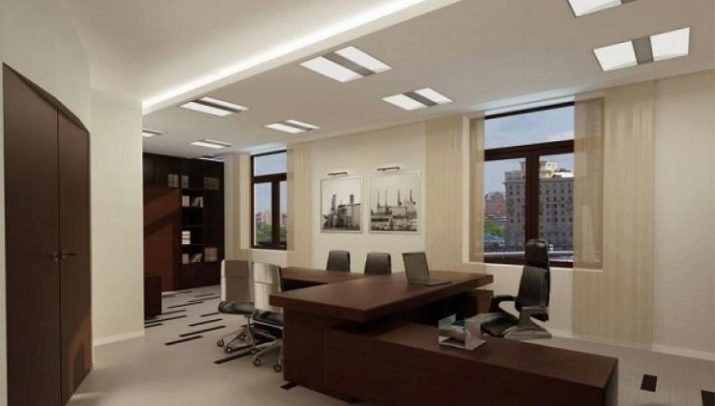

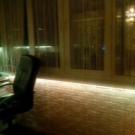


Criterias of choice
LED strip lighting has a lot of varieties. Before buying, determine the type of lighting.
If this tape will perform the function of general lighting, all lighting fixtures are removed from the ceiling. Then several tapes of higher power are fixed on the ceiling, placing them around the perimeter, as well as behind the stretch ceiling film (costly method). To accentuate the contours, this self-adhesive backlight is fixed along the perimeter of the niches, creating diffused light and the visual effect of increasing the space.
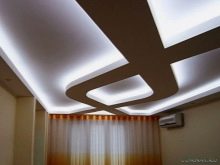
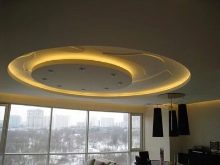
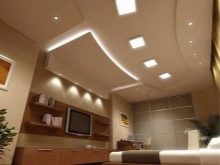
If you need to highlight a curly ledge, you can partially repeat its shape, which is especially important for suspended structures. At the same time, the flexibility of the tape does not limit the curvature of the line.
If the illumination of the ceiling is planned to be repeated, for example, by highlighting the shape of a mirror or facing a kitchen apron, they acquire varieties that are the same in glow. In order to choose the LED strip correctly and not get confused in the wide range of the presented assortment, you need to decide on the type of attachment, the shade of the glow, the power of the light sources and their number. The design idea also matters, on which the final effect of light transmission depends.
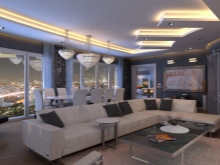
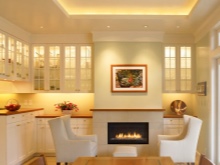
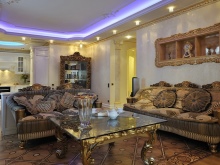
Therefore, when buying, it is worth paying attention even to the substrate: it is undesirable for it to be conspicuous. It is acquired to match the color of the main background of the ceiling. It can be not only white. On the market for similar products, you can find options with a brown, gray and even transparent base.
Glow tint
Ribbons are not simply divided into plain and colored. In the first case, these are bulbs that burn exclusively in one shade (for example, white, blue, yellow, orange, green). In addition, these varieties can emit infrared and ultraviolet light. The second is a tape with built-in bulbs that can glow in different colors, alternately or simultaneously. The different capabilities of the tapes affect the price: options with a light switching mode are more expensive.
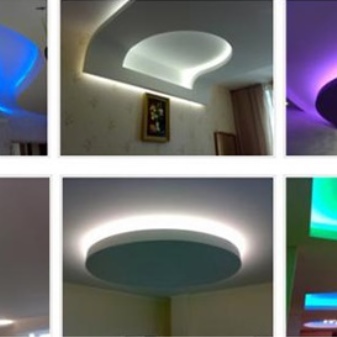
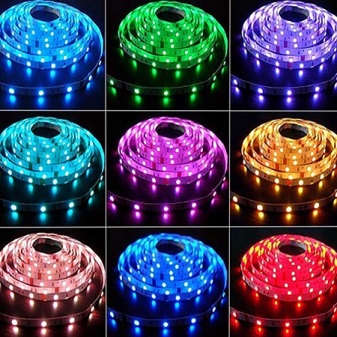
Power and density
If the main requirement of the backlight is the brightness of the luminous flux, you should purchase a product with a smaller gap between the diodes. At the same time, electricity consumption will be greater than that of varieties with rarefied bulbs. If the lighting in the ceiling design will only have a decorative function, it is enough to buy an LED system for decorating the ceiling zone - a system with about 30-60 LEDs per 1 m. For the main illumination, a tape with 120-240 bulbs per 1 m length is suitable.
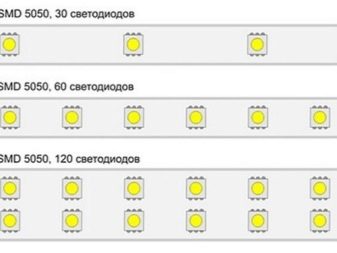

In this case, a nuance is important: the more spacious the room, the larger the width of the tape should be. A narrow version on a high ceiling of a large area will be lost. Better to decorate the ceiling area with a wide variety with LEDs in 2 rows.
Examining the board
In fact, everything is simple here: the abbreviation SMD, indicated on the tape, stands for "surface mount device". There are 4 numbers next to the letters: this is the length and width of one LED. Of the options presented, the most relevant choice is the parameters 3020 (3 x 2 mm), 3528 (3.5 x 2.8 mm), 5050 (5 x 5 mm). The larger the diodes and the density of their placement, the brighter they shine. Each type of belt has a different capacity. For example, SMD 3528 with 60 diodes per 1 m consumes 4.8 W, if there are 120 light sources, the power is 9.6 W. If there are 240 of them, the consumption is 19.6 watts.
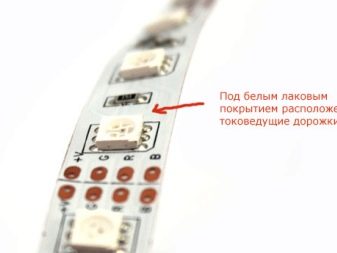
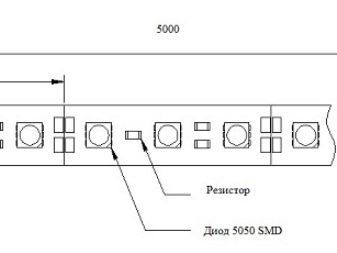
Footage
The footage of the tape depends on the perimeter of the glued ceiling plane. Since LEDs differ in the intensity of the glow, they do not buy it at random: if the space is small, excess light will hit the eyes. Simply put, a total volume of 11 W will replace a 100 W incandescent light bulb.
To select the level of light, measure the required footage of the illuminated area using a tape measure. After that, the resulting figure is multiplied by the power of 1 m of the tape.This value will allow you to decide on the purchase of a power supply or controller, if you plan to buy a tape with multi-colored lamps for decorating the ceiling.

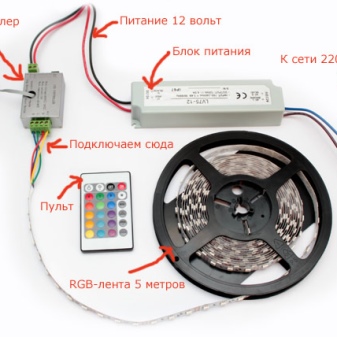
As a rule, the footage of tape for lighting the ceiling is 5 meters, although today such a product can be bought in a shorter length.
Protection class
Each type of LED strip is designed to decorate the ceiling of different types of premises.
Returning to the topic of notation, it is worth considering the marks:
- IP 20 is a mark indicating the possibility of using LED strips in dry rooms (living rooms, children's rooms, offices, corridors).
- IP 65 is an indicator indicating that the board can withstand contact with moisture, it can be used in "wet" areas (places where leaks are possible near neighbors on top).
- IP 68 - category with insulation.
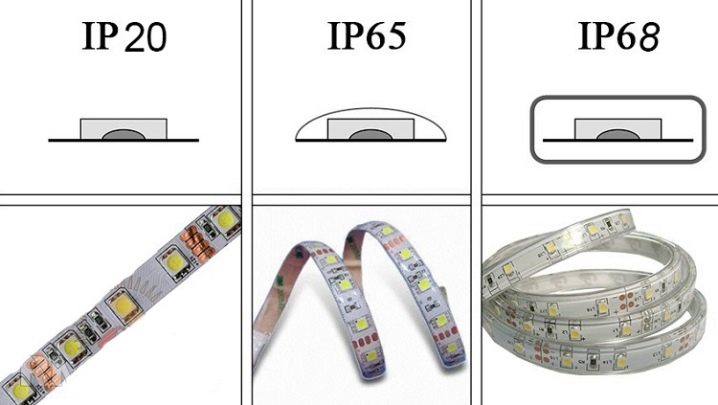
When buying, it is worth considering that varieties with a silicone layer are not suitable for decorating the ceiling, since they conceal the intensity of the luminous flux, force the substrate to heat up, which provokes heating of the surface of the ceiling finish.
Mounting
Do-it-yourself LED lighting installation is easy. However, before installation, it is worth considering the fact that the tapes dissipate some of the energy in the form of heat. Therefore, before fixing and connecting the backlight, in some rooms it is necessary to think over the insulation. For diodes with higher power, this can be an aluminum substrate. If the backlight power is low, the lamp is needed as decorative lighting, insulation is not necessary.
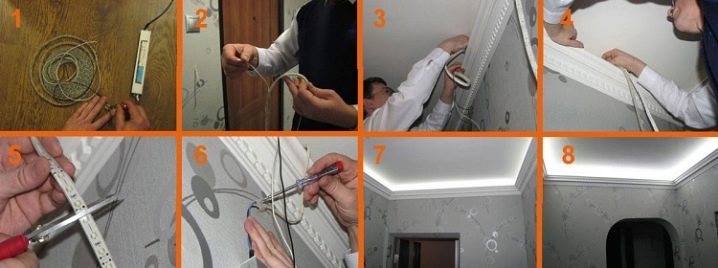
In the skirting board
This method is convenient because the backlight can be mounted on the ceiling after installing the ceiling covering. The main task is to buy an attractive skirting board, while it is important to take into account that it is not thin. This can cause the backlight to lose its expressiveness. At the beginning of work, the plinth is attached to the ceiling using reliable glue (for example, liquid nails), leaving a channel about 8-10 cm from the ceiling. To keep the cornice even, you can mark out using a level.
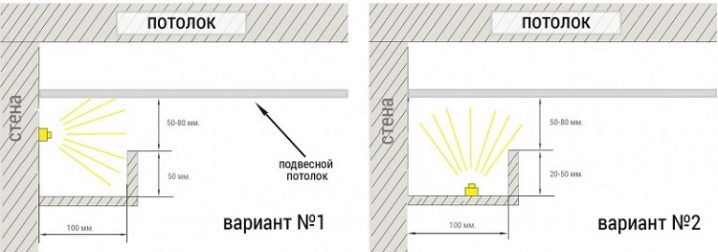
After the glue has set and dries, proceed to the installation of the tape. To do this, the surface of the skirting board is cleaned, the adhesive layer is removed from the back side of the backlight, and it is mounted on the ceiling or the back side of the skirting board in the left gap. If the installation of the self-adhesive tape seems unreliable, you can glue it in several places with silicone glue or double-sided tape. It remains to connect the power supply, and for multi-colored RGB varieties, the box, taking into account the polarity. After checking the voltage in the system, you can connect the tape to the 220V power supply.
In a plasterboard cornice
You can hide the lighting in a plasterboard box when installing the ceiling. At the time of the construction of the system, an open or closed niche is made for laying the built-in strip lighting. The structure of the box is made according to the markings, connecting the bearing profiles with CD-elements to the walls, forming a niche. In this case, whatever the system may be (single-level, two-level or multi-level), it is necessary to mount it with a gap of 10 cm in order to ensure the passage of light from the LEDs.
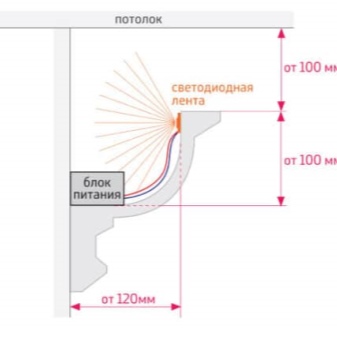
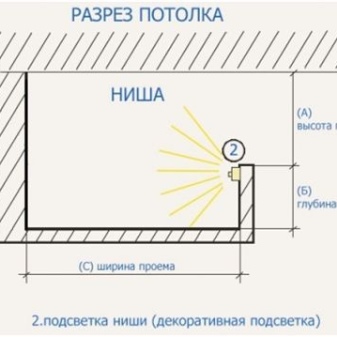
Plasterboard sheets are placed on the frame, leaving a niche for tape illumination. The perimeter of the box is closed with a side (cornice), which will later hide the fastening of the tape. The seams are masked, primed and painted, then the self-adhesive backlight is mounted directly on the drywall. Fixation is carried out in such a way that the light of the LEDs is directed from bottom to top. After observing the polarity, the system must be connected to the current conductors.

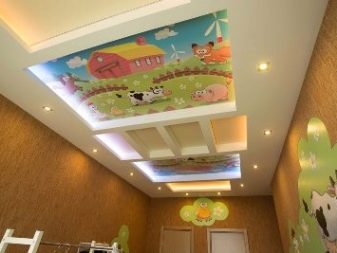
Design
Ceiling decoration with LED strip is varied. It depends on creativity, ceiling design, overhangs, patterns, and type of fixture. The light strip can be located along the perimeter of the ceiling, be an element for decorating multi-level structures.There are many options for its location, in each case it creates an individual effect.
The illumination of the ceiling with an LED strip looks especially interesting, participating in the accentuation of the protrusions of the structures. For example, the highlighting of the second level with a combination of a tape and a central lamp will be beautiful. At the same time, they try to choose the backlight in such a way that its shade coincides in temperature with the central light.
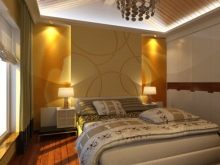
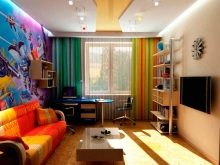
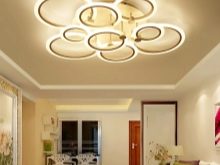
The tape hidden in the niche of the suspended structure will emphasize the desired area of the ceiling, due to which the room can be zoned. For example, in this way you can highlight the dining area in the living room combined with the dining room. The same technique can favorably accentuate the guest area, creating a special atmosphere in it due to the color shade.
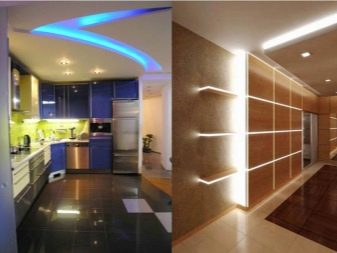
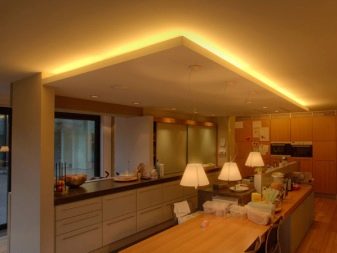
The illumination of the curly lines of a certain part of the ceiling composition looks beautiful. It can be a monochromatic coating or a stretch ceiling design with photo printing. The use of a diode strip along the perimeter of the pattern gives the image a volume and a special effect. Lighting small prints changes their perception, it is a tool for adding the right mood to the interior. Such lighting makes the ceiling visually wider and lighter, even if the structure consists of several levels.
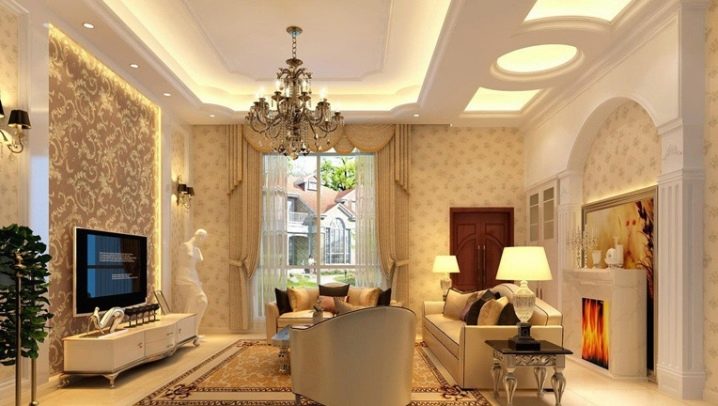
The texture of the ceiling is also important. For example, LED strip lighting is reflected in a glossy canvas, visually adding light to the space, which is especially important for rooms with windows facing north and spaces with small window openings. The upward direction of the diodes creates a soft light, the attachment to the side of the niche provides a directional flow and a "floating ceiling" effect.
Installing a tape between the coating material and the base creates the illusion of a glow from the inside. A tricky trick is to create designer lighting by means of a tape inside a stretch ceiling. Often for such systems, additional threads are used with a glow source at the ends of the fibers.
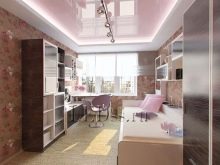

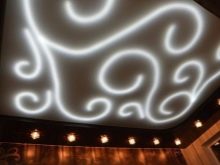
Tips & Tricks
To make the illumination as correct as possible, the places of the cuts must be fixed by means of a connector or a soldering iron. In this case, you must not act on the material for more than 10 seconds. In single-color versions, it is necessary to connect the contacts "+" and "-".
In RGB-type boards, the contacts are combined based on the color and markings, where:
- R is red;
- G - green;
- B - blue;
- 4 pin = 12 or 24 V.

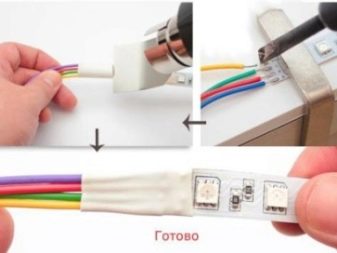
The transformer cord is connected to pins N and L. If an RGB tape is connected, a controller is added to the system. In this case, it is important not to confuse the values "+" and "-", this can lead to breakage of the tape. When making the connection, take into account the fact that the transformer is designed for a maximum total length of the backlight up to 15 m. If the perimeter of the diode backlight is larger, an additional power supply must be added to the system.
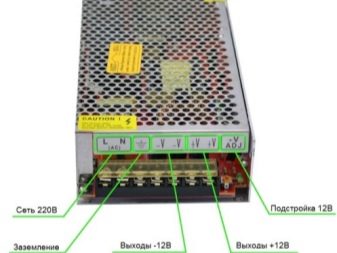
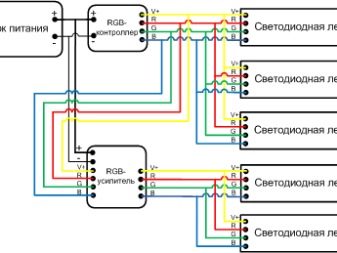
In order not to suffer from a negative perception of color in the future, the tape must be chosen correctly. Don't buy a single color backlight model. Consider the influence of the shade: red provokes anxiety and aggression, blue at first calms, but with a constant glow, day after day, provokes depression, then depression.
The yellow light in the daily illumination of the space creates a depressing atmosphere. Purple is good for temporary lighting in the room of young households, but it is contraindicated for older family members. Therefore, when buying, for practical reasons, it is worth choosing between white backlighting for daylight and varieties with a color change. This will allow you to vary the shades of the luminous flux according to your mood, without getting used to them.


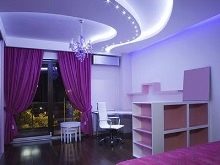
Remember to clean the surface before gluing the LED strip. So it will keep on it more reliably and longer.Even if initially the surface, for example, of a cornice, seems clean, it is worth wiping it, getting rid of dust, which can cause the sticky layer to peel off. You can cut tapes only in the places marked for cutting.
Beautiful examples in the interior
To choose your own version of lighting the ceiling with LED strip, you can refer to examples of beautiful designs from the photo gallery.
- A classic example of accentuating a ceiling ledge with strip lighting combined with spotlights.
- Flexible ribbons favorably emphasize the curly lines of the two-level ceiling, accentuating the guest space of the living room.
- The selection of a complex design of the dining area with a counter table looks unusual, while it is not devoid of harmony.
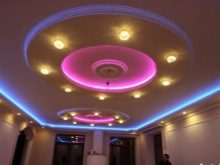
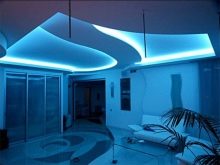
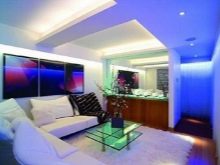
- The reception of a combination of LED lighting and spotlights due to different shades allows you to create a whimsical ceiling composition.
- The unusual version of the integrated strip lighting with a lightning effect on the ceiling looks impressive.
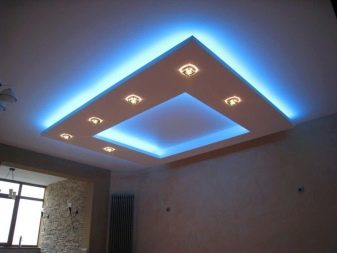

- Accentuating a multi-level ceiling space with different colored lighting creates a unique effect.
- Highlighting a small fragment of a stretch ceiling with tape lighting creates the illusion of a realistic image.
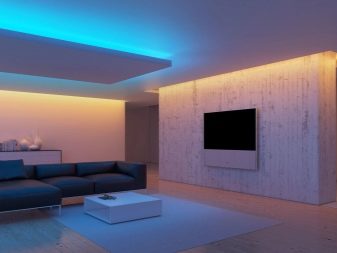
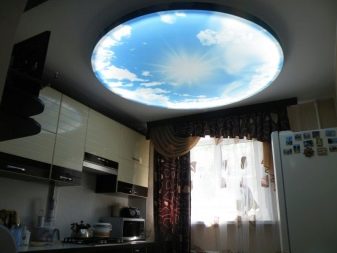
In this video, you will find a master class on installing an LED strip, and useful tips to help you avoid common mistakes.













The comment was sent successfully.